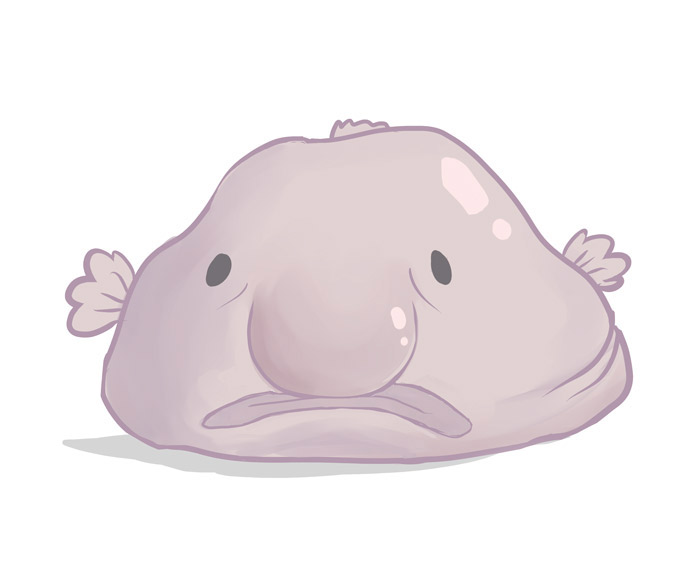Ever pictured a cross between Squidward from Spongebob and a grumpy English Bulldog? If not, look at a picture of the infamous “blobfish” and wonder at the mysteries of life.
According to the New York Daily News, the blobfish, or Psychrolutes marcidus, was voted “World’s Ugliest Fish” by the Ugly Animals Preservation Society in 2013. Since this crowning achievement, the blobfish has floated into the hearts of an adoring fan base through a series of memes, and children’s books: The Blobfish Book and Pink is for Blobfish. There have even been “plush blobfish” manufactured to bring the bubblicious-pink, squishy fish into the arms of adoring children.
During last year’s U.S. presidential election, the blobfish became increasingly famous. Pictures of the gelatinous animal were compared to President Donald Trump—the two sharing striking physical similarities. In one photo, an innocent blobfish had Trump’s orange hair photoshopped onto its head, further affirming the uncanny resemblance between the two in the eyes of the Internet.
“Mr. Blobby” has other look-alikes, many of which were highlighted during the fish’s exhibition at the Australian Museum’s Ichthyology Collection.
“Schoolchildren were encouraged to leave mash notes [at the museum’s Blobfish display case],” Franz Lidz wrote in Smithsonian Magazine. “The most memorable: ‘You remind me of my teacher.’”
But who are these creatures under their crotchety countenance? As it turns out, scientists know relatively little about the blobs.
“[Scientists] fear the blobfish, which can grow up to 12 inches, is in danger of being wiped out by over-fishing in its south eastern Australian habitat,” author Andrew Hough wrote in a 2010 article published in The Telegraph. The species are now on the endangered species list.
Lidz writes that scientists in New Zealand and Australian first discovered the species around the Norfolk and Lord Howe Islands while exploring submarine habitats. This benthic—or bottom-dwelling—fish lives up to 4,000 feet below sea level on the ocean floor. In fact, the pressure of the water provides their bodies with structural support, rather than having a swim bladder, or developed muscles and skeletons. Their bodies, less dense than the water around them, allow the fish to float along the sea floor without a swim bladder—the organ that allows most fish species buoyancy.
In reality, blobfish only really move when they need food and can’t get it while sitting still—much like university students on a Sunday morning.
As eloquently written by Michael Hearst in Unusual Creatures, “Blobfish, blobfish, JELL-O of the sea—Floats upon the bottom, lazy as can be.”
Contrasting against human beauty standards, the blobfish body’s gooey composition and lack of a swim bladder evolved as an adaptation for survival in the deep ocean.
“A lot of fish with swim bladders caught in deep waters and then [brought] up [to shallower waters] have their guts pushed out of their mouths, essentially because they can’t get the air out of their swim bladder fast enough,” Dr. Andrew Hendry, professor in the McGill Department of Biology and researcher at the Redpath Museum, said. “I don’t know of any fish that [change composition in changing pressure levels] with as much aplomb as the blobfish.”
Because of the extreme pressure, Mr. Blobbly looks like a regular fish on the ocean floor.
“Why [is…] the world […] too hard on the blobfish?” Colin Shults asked in an article for Smithsonian Magazine. “Because if we put [humans] 4,000 feet below the water [their] organs would be crushed and [they’d] probably be turned into some sort of paste. Meanwhile the blobfish would just look like…well…a fish.”
Little else is known for certain about the blobfish. Nevertheless, its influence on the laughs and smiles worldwide have made it the most iconic fish of the 21st century.










Raul,
thank you for your wholesome comment that is currently in the acceptance process.
John Luis, Moderator
Hi my name is Erin and I am looking to teach a class about the blobfish on a teaching platform called Outschool. May I have permission to use the above photo by Erica Stefano to use as an illustration. Please forward this message to whomever it needs to go to. Thank you!
I’m interested in using the picture of the Blowfish above to put on stickers and clothing to sell. May I have permission to use it? Please forward this message to whomever it needs to go to. Thank you!